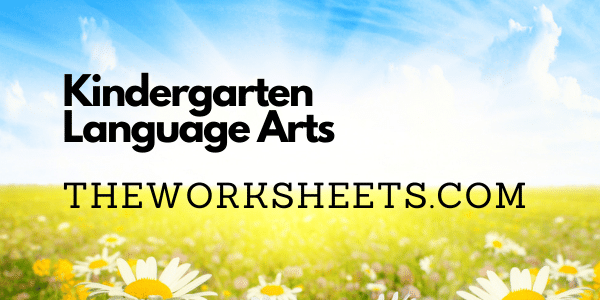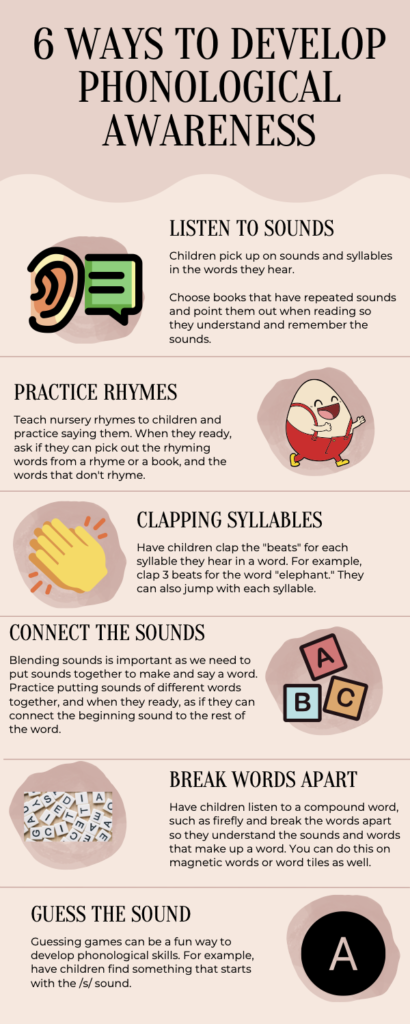Kindergarten Language Arts Worksheets – A Intriguing Collection
May 14, 2022 by admin

When kindergarten children set foot in daycares or full-day kindergarten classrooms, their journey of language learning begins. While it is tempting to introduce them to the English language with words and sentences (as this is how we communicate to one another), the more we practice “pre-reading” skills with them, for example, noticing and playing with rhymes, sounds, words and syllables, the more they will be prepared to learn to write and write.
According to Ontario’s Kindergarten Program, as children progress through kindergarten, they are expected to demonstrate literacy behaviors that enable early readers to make sense of a variety of texts and communicate with others. So how can we set them up for success?
By developing phonological awareness, which is the ability to recognize, tune in and work with sounds in spoken language, children will understand how a word is made, and build on their vocabulary, all of which prepares them to read and write.
Phonological awareness encompasses multiple skills, which includes identifying syllables in a word, identifying rhyming words, recognizing beginning and ending sounds, blending sounds to say a word and breaking words into separate sounds.
At TheWorksheets.com, we have a wealth of resources on various subjects, including language arts worksheets that are aligned with the Ontario curriculum and designed to help educators and parents to teach kindergarten-aged children phonological awareness skills. The worksheets are selected and curated by experienced teachers and professionals who are subject matter experts in language, math and social studies. Here are 6 ways to teach phonological awareness to kindergarten-aged children:
[Infographic] – 6 ways to develop phonological awareness in kindergarten-aged children

Listen intently to the sounds
Children pick up sounds from the words they hear, but they may not be aware of concepts such as syllables, phonetic sounds and rhymes. Reading aloud is a great way to introduce them to different kinds of sounds, such as vowels and digraphs, and language conventions, such as rhyming.
You may want to choose books that repeat the same sounds throughout to consolidate their understanding of a particular sound. For example, if the book involves counting fish, such as “one fish, two fish, three fish”, emphasize the “f” sound when reading the word fish, and ask the children to listen to the “f” sound. After reading time, you can draw their attention to words that start with “f” sound in the classroom or at home.
Here are worksheets on reading and different kinds of sounds:
Vowel Worksheets
Consonants Worksheets
Digraph Worksheets
Kindergarten Reading Comprehension Worksheets
Practice Rhymes
Rhyming is a great way to develop phonological awareness, as it introduces to children that while some words sound the same even though they have different meanings, not all of them do.
A fun way to introduce rhyme is to teach nursery rhymes to children and practice saying or singing them together. Once they are familiar with rhyming conventions, you can say a group of words, such as “clap, slap, tap, tail” and see if they can find the words that rhyme and the odd word that does not rhyme. When they are ready, they can design their own rhymes as well!
Learning rhyme requires children to listen carefully to the sounds in words they hear and reading aloud provides many opportunities to teach them about rhyme. When reading, choose books that contain rhymes and draw their attention to words that sound similar as you read, and
Here are some worksheets to introduce children to rhyme:
Rhyming Worksheets
Rhyme Worksheets
Words that Rhyme Worksheets
Rhyming Words Worksheets
Clapping Syllables
Syllables are a way to organize speech sounds. Typically, they are a part of a word that contains a single vowel sound and is pronounced as a unit. For example, the word “book” has one syllable, while the word “banana” has three syllables. To make syllables easier to understand for children, we can play a game of clapping with them. In the clapping game, choose a word, pause as you say each syllable of the word, for example ba-na-na, and clap out each syllable together. For children who do not like clapping or want to use another way to identify syllables, jumping or stomping each syllable can be good alternatives as well if there is enough space and no sound restrictions.
Once the children are familiar with the concept of syllables, you can encourage them to host the clapping game, where they choose the word and clap out the syllables, or choose the words and have others in the group find the number of syllables by clapping.
Here are some worksheets to build children’s skills and understanding of syllables:
Syllables Worksheets
Multisyllabic Words Worksheets
How Many Syllables Worksheets
Syllable Patterns Worksheets
Connect the Sounds
Blending and combining sounds are important skills for early readers as they need to put sounds together to be able to make and say a word smoothly. You can teach children how to blend and combine sounds of different words by connecting the beginning sound of a word with the rest of the sound. For example, pick a word (cat) and ask the children, start with “c” and add “a” and “t”, what word would you hear if you put them together?
To make blending and combining sounds a fun process, they can use magnetic word tiles, word cards or strips of paper with words written on them to make words. As children build their vocabulary, they can practice making words by blending digraphs and vowels to make longer and more words. For example, using magnetic tiles, they can see if they can make a word, starting with the digraph “st” and adding the sounds “a” and “r”.
Here are some worksheets to introduce children to blending and combining words:
Sounds and Letters Worksheets
Sound Blends Worksheets
Consonant Blends Worksheets
Blend Activities Worksheets
Breaking words apart
The opposite of making words is breaking words apart, but it is an equally important skill as children can see that a word can be made up of two or more words. Breaking words also sets the scene to teach compound words.
One way to practice breaking words apart is to have children hear a word and take it apart. Choose compound words such as “toothbrush”, “cupcake” and “jellyfish”. Ask the children to say the compound word aloud, and then take away a part of the word, such as “cake” in the word cupcake. Then ask them what word is left.
For visual learners, magnetic letters and word tiles are also good alternatives to break words apart. These materials can be easily manipulated and broken apart, and children can visually see how compound words can be made. They are also great fun to work with as well! If you don’t have magnetic letters, you can also consider writing letters on stripes of paper and cutting them.
Here are worksheets to build on children’s understanding of alphabetical letters and compound words:
Alphabetical Letters Worksheets
Trace Alphabet Worksheets
Sight Words Worksheets
Compound Words Worksheets
Guess the Sound
Building phonological awareness can be a fun and interactive learning experience! As children learn more about different kinds of sounds in a word and how to pronounce them, guessing games are engaging ways to assess and consolidate their understanding of phonological sounds, and can work on almost any phonological skill.
For example, if you would like children to practice noticing sounds that begin with a particular sound, you can introduce a spying game, where you provide a hint, such as “I spy something blue that starts with “s” and encourage children to find something in the classroom and at home that starts with the s sound. Another game is to have children sit in a circle, and as we go around the circle, each child will say something that starts with a certain sound, for example, the “f” sound.
For older children who are more familiar with language conventions, you can use the same game with rhymes. For example, try saying something such as “I spy someone wearing something warm that rhymes with boat”, and ask the children what it is. The children can then continue to find something at home or classroom that rhymes with that particular word.
Here are links to worksheets to practice on understanding different sounds:
Phonics Worksheets
Phonemes Worksheets
Beginning and Ending Sounds Worksheets
Short Vowel Sounds Worksheets
What happens next?
Once children understand how a word is constructed and other language conventions that are used in the English language, they will have a strong foundation for reading and writing. As they continue to learn how to read and write, they will be guided on how to communicate with one another. Communication skills not only consists of verbal and written communication, in which they talk to others and write to express their ideas, but also consists of the ability to use and interpret others’ verbal and non-verbal cues, such as the tone of a voice or a classmate’s expression. As their vocabulary continues to grow, children are taught how to use language to describe and connect with their experiences. For example, after a reading session, they may be asked to discuss and find a solution for a character of a book, or make predictions on what will happen next in the story.
You Can Trust TheWorksheets.com!
A strong language foundation helps children to understand the world around them and become efficient communicators who can communicate to people of different ages and backgrounds in various contexts. It is vital for them to master skills and strategies so they can express their thoughts, and understand how the English language works. By developing and building their language and literacy skills, they will be better prepared for their schooling years and life beyond.
Theworksheets.com has many resources to help each child to grow their language skills.